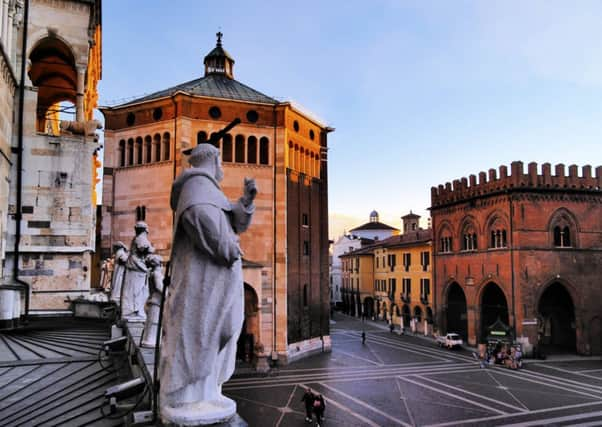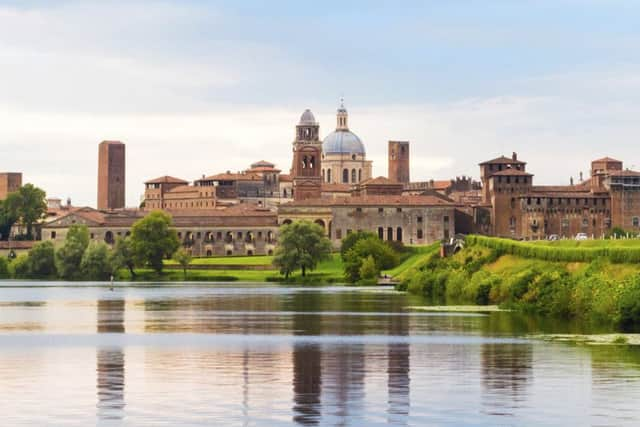Travel: Cremona and Mantua, Lombardy
This article contains affiliate links. We may earn a small commission on items purchased through this article, but that does not affect our editorial judgement.


THE trouble with sightseeing in Italy is that an overdose of art, architecture and music can obscure the darker side of history. Lombardy is no exception.
The Gonzaga family ruled Mantua for the best part of four centuries, building a vast complex of palaces and churches there. They were great patrons of the arts. So dazzling is their legacy that it would be easy to overlook how they acquired all that wealth. A painting by Domenico Morone in the Palazzo Ducale shows that it was not all business acumen and marriages of convenience. The subject is their bloody seizure of the city in 1328. The Gonzagas commissioned it themselves. You could see it as a sort of shameless selfie.
Advertisement
Hide AdAdvertisement
Hide AdCremona’s fame is founded on harmony. It is the world capital of violin making. Its exquisite Ponchielli Theatre, whose sweeping horseshoe of cream and gilt wooden tiers rises vertically to the gods, hosts an annual Monteverdi Festival. The composer was born in the city. A plaque at the entrance records that the theatre was re-inaugurated in December 1930, “in the 9th year of the Fascist era”. It serves as a reminder that confrontation between Blackshirt squads and the left was particularly violent in this region.


The two cities sit on the wide, fertile plain watered by the River Po. This plain is so flat and devoid of intervening natural features that from the top of Cremona’s soaring bell tower on a clear, windy day you can see the Alps to the north and the Apennines to the south. Some roads run along levees for fear of flooding. Many fields produce risotto rice, which grows especially well here. Legend has it that risotto Milanese came about by accident when saffron being used on a stained glass window in Milan’s sumptuous Gothic cathedral fell into a dish being prepared for the wedding of an artisan in charge of the work.
In his Divine Comedy, Dante called Mantua the city in the swamps. It lies on the Mincio, which flows from Lake Garda into the Po. With a later connection by canal, you may travel all the way from there to Venice by boat. In the 12th and 13th centuries the swamps were drained by diverting the river to create three lakes, which served as a defensive barrier.
The city’s visual impact is marred by scaffolding thanks to the earthquake, which struck in May 2012, but most of its fascination lies behind walls. The astonishingly enormous cathedral, burial place of the artist Andrea Mantegna, is mostly hidden behind secular buildings. In the crypt is the Blood of Mantua, the reason for the basilica’s foundation, which is said to have been collected from the earth below the cross and brought there by the Roman soldier Longinus, who plunged his spear into Christ’s side and proclaimed him the son of God.
Mantua’s theatre, where a 13-year-old Mozart played his own harpsichord concerto in 1770, is very different from Cremona’s – but just as lovely. Commissioned by the Austrian Empress Maria Theresa, its balconies of wood, made to resemble marble, conform harmoniously to a bell-shaped floor plan.
There’s not a huge amount of art left in the Palazzo Ducale. Some was sold to Charles I of England when the Gonzagas ran into financial problems. Much of it was looted by Napoleon’s army. But there’s also the Palazzo Te – an abbreviated name for the island on which it once stood – an overblown love nest where a young Marquess of Mantua entertained his mistress, complete with a room whose explicit frescos can only be described as renaissance pornography and another whose painted giants prompted Dickens to see them as a nightmare which might induce an apoplectic stroke.
The exterior of Cremona’s cathedral and the interior of the adjacent baptistery’s mind-boggling red brick dome are part of a delicious architectural ensemble, but it is for the violin that most people come. No-one knows where the violin was invented, but the city has made the instrument its own. There are now fewer than 157 violin makers in the city. Not all are Italian. I visited one whose grandfather, a friend of the great runner Emil Zatopek, came from Hungary to found a workshop. To make one instrument, he said, took an average of about two months.
It’s not clear whether the great Antonio Stradivari was born in Cremona, but he worked there. You may see some of the results in the city’s superb, recently opened, violin museum. They sit alongside examples made by other masters, such as Andrea Amati, who fathered the tradition of violin making in the city and whose son Nicolo trained the young Stradivari. Made principally of spruce from the Dolomites and maple from the Balkans, the instruments are lit reverentially under glass.
Advertisement
Hide AdAdvertisement
Hide AdReverence, however, does not prevent them being played. Visitors can hear recordings in an acoustic wooden shell. I was fortunate enough to hear a brilliant young musician, Lena Yokoyama, play pieces by Massenet and Paganini on the 1727 Stradivari Vesuvius – so-called because its reddish hue hints at molten lava. We heard that another violin, normally on show but then on tour, had been played at Auschwitz. More dark thoughts. But now, so far from worrying that a surfeit of beauty might soften the brain, I was content to let those gorgeous tones soothe them away.
• Roger Bray flew to Milan with easyJet (www.easyjet.com) from Edinburgh. It is possible to travel between Cremona and Mantua by train.
• Further information on Lombardy at http://wonderfulexpo2015.info/en/ a website designed to accompany this year’s Expo in Milan, or at www.turismo.regione.lombardia.it/en/.